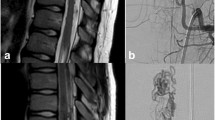Abstract
Background and purpose
A minority of patients with spinal arteriovenous malformations (SAVM) are symptomatic as neonates or infants. We analyzed the clinical and anatomic factors associated with this early presentation, and reviewed our experience in treating patients with these lesions.
Methods
A retrospective review of clinical records and imaging studies was performed for patients with SAVM who presented at less than 2 years of age and who were examined by the diagnostic and interventional neuroradiology service at our institution. Clinical, imaging and treatment data had been entered prospectively into a department database.
Results
Thirteen patients were identified that had SAVMs that were either diagnosed or that became symptomatic before 2 years of age (nine boys, four girls). These represented 13% of the SAVM seen during the same period of time. The mean age at presentation was 6.9±6.4 months. Of the 13 patients, 11 had neurologic symptoms attributable to the spinal lesion. The presentation was nonhemorrhagic in ten patients and associated with hemorrhage in three. Ten lesions were fistulas [spinal cord arteriovenous fistulas (SCAVFs)] (77%); two were of the nidus type of malformation. There were syndromic associations in eight patients: hereditary hemorrhagic telangectasia (HHT) in six patients, all but one of these lesions were intradural high-flow perimedullary SCAVFs (46% of overall SAVM and 56% of SCAVF), and spinal arteriovenous metameric syndrome in two patients. One patient had Hirschprung’s anomaly. Eight patients underwent endovascular treatment alone, one had surgery and embolization, and four were not treated. In all patients undergoing embolization, n-butyl cyanoacrylate liquid adhesive was used. Of those patients who underwent endovascular treatment, the lesion was completely obliterated in 7 and a 90% reduction in nidal size was achieved in the remaining 2. There was one treatment complication (infection) which resolved with medical therapy. No procedure-related permanent morbidity or mortality was seen. Follow-up data were available (mean 31.4 months) in ten patients (nine treated). All treated patients were either stable or improved, with none showing further deterioration following treatment.
Conclusion
Factors associated with early presentation in neonates and infants with spinal arteriovenous shunts include the presence of high-flow, solitary fistulas and HHT. Specifically, the presence of SCAVF in a child less than 2 years of age is highly suggestive of HHT. Despite the aggressive nature of these lesions, many are amenable to endovascular treatment, and this is associated with a favorable posttreatment course in most cases.




Similar content being viewed by others
References
Ikezaki K, Miyoshi K, Muratani H, Ogata N, Goto K, Fukui M (2000) Spinal intradural perimedullary arteriovenous fistula with varix in infant. J Clin Neurosci 7(Suppl 1):50–53
Bjork A, Eeg-Ologsson O, Svendsen P, Mostrom U, Pellettieri L (1994) Endovascular treatment of a spinal arteriovenous malformation in a 21-month-old boy. Acta Paediatr 83:1326–1331
Esparza J, Perez-Higueras A, Perez-Diaz C, Ramo C (1987) Arteriovenous malformation of the spinal cord in the neonate. Childs Nerv Syst 3:301–303
Morgan MK, Chaseling R, Johnston I, de Silva M (1986) Spinal arteriovenous malformation presenting at birth: case report. Neurosurgery 19:637–640
Park TS, Cail WS, Delashaw JB, Kattwinkel J (1986) Spinal cord arteriovenous malformation in a neonate. Case report. J Neurosurg 64:322–324
Tada T, Sakamoto K, Kobayashi N, Tanaka Y (1985) Arteriovenous malformation of the spinal cord in a 17-month-old child. Childs Nerv Syst 1:298–301
Mont’alverne F, Musacchio M, Tolentino V, Belzile F, Riquelme C, Tournade A (2003) Giant spinal perimedullary fistula in hereditary hemorrhagic telangiectasia: diagnosis, endovascular treatment and review of the literature. Neuroradiology 45:830–836
Mandzia JL, terBrugge KG, Faughnan ME, Hyland RH (1999) Spinal cord arteriovenous malformations in two patients with hereditary hemorrhagic telangiectasia. Childs Nerv Syst 15:80–83
Rodesch G, Hurth M, Alvarez H, Tadie M, Lasjaunias P (2002) Classification of spinal cord arteriovenous shunts: proposal for a reappraisal—the Bicetre experience with 155 consecutive patients treated between 1981 and 1999. Neurosurgery 51:374–379
Rodesch G, Hurth M, Alvarez H, Ducot B, Tadie M, Lasjaunias P (2004) Angio-architecture of spinal cord arteriovenous shunts at presentation. Clinical correlations in adults and children. The Bicetre experience on 155 consecutive patients seen between 1981–1999. Acta Neurochir (Wien) 146:217–226
Yoshida Y, Weon YC, Sachet M, Mahadevan J, Alvarez H, Rodesch G, Lasjaunias P (2004) Posterior cranial fossa single-hole arteriovenous fistulae in children: 14 consecutive cases. Neuroradiology 46:474–481
Weon YC, Yoshida Y, Sachet M, Mahadevan J, Alvarez H, Rodesch G, Lasjaunias P (2004) Supratentorial cerebral arteriovenous fistulas (AVFs) in children: review of 41 cases with 63 non choroidal single hole AVFs. Acta Neurochir (Wien) 147:17–31
Chul Suh D, Alvarez H, Bhattacharya JJ, Rodesch G, Lasjaunias PL (2001) Intracranial hemorrhage within the first two years of life. Acta Neurochir (Wien) 143:997–1004
Ricolfi F, Gobin PY, Aymard F, Brunelle A, Gaston A, Merland JJ (1997) Giant perimedullary arteriovenous fistulas of the spine: clinical and radiologic features and endovascular treatment. AJNR Am J Neuroradiol 18:677–687
Halbach VV, Higashida RT, Dowd CF, Fraser KW, Edwards MS, Barnwell SL (1993) Treatment of giant intradural (perimedullary) arteriovenous fistulas. Neurosurgery 33:972–979
Author information
Authors and Affiliations
Corresponding author
Rights and permissions
About this article
Cite this article
Cullen, S., Alvarez, H., Rodesch, G. et al. Spinal arteriovenous shunts presenting before 2 years of age: analysis of 13 cases. Childs Nerv Syst 22, 1103–1110 (2006). https://doi.org/10.1007/s00381-006-0075-x
Received:
Revised:
Published:
Issue Date:
DOI: https://doi.org/10.1007/s00381-006-0075-x




